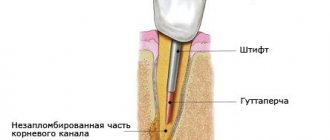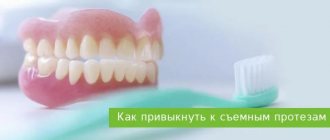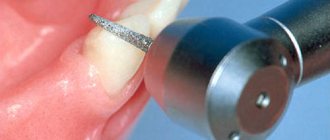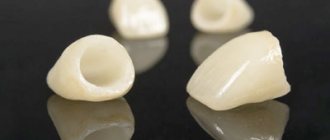Many patients of orthopedic dentists after prosthetics talk about how difficult it was for them to get used to dentures. High-quality permanent artificial teeth and crowns are compact in size and do not cause any discomfort. But with removable ones, problems arise: from unpleasant sensations in the palate and irritating pressure on the gums to constant nausea and even a gag reflex. Each patient experiences the adaptation process in his own way, so it can last only a couple of days, one or two weeks, or several months.
Why does discomfort occur?
A person with missing teeth gets used to living without them. His dental system begins to distribute the chewing load differently, and the muscles, cheeks, nerves, tongue and jaw bones involved in the process gradually get used to the restructuring that has occurred.
If missing teeth can be restored with permanent dentures, the parameters of which are almost identical to natural teeth, the load when chewing food turns out to be natural. And the absence of foreign elements - fixing hooks and staples - guarantees the absence of irritation of the mucous membranes of the cheeks and tongue.
In removable structures, the chewing load is distributed differently. For example, popular clasp dentures distribute it to the palate and the remaining adjacent teeth. It is clear that the sensations when chewing food will be unusual at first and will almost certainly cause irritation.
Inflammation of the salivary gland
The salivary glands are responsible for the process of producing saliva, which is necessary for the primary digestion of food and protecting the oral cavity from pathogenic microorganisms. At the initial stage, the inflammation passes without symptoms. The patient seeks medical help in more advanced cases. Lack of therapy threatens with impaired salivation, salivary stone disease and blockage of the salivary ducts. Manifests:
- swelling of the chin, lower jaw and nearby tissues;
- increased temperature;
- pain when swallowing, chewing food, opening the mouth;
- daily deterioration of health.
Why is this happening?
If inflammation of the salivary gland (sialadenitis) occurs after installation of the implant, the cause may be damage to the duct during drilling of the site for the titanium rod. Other reasons:
- inflammatory process in the tonsils;
- poor hygiene;
- infectious diseases, such as tonsillitis;
- stagnation of secretions in the ducts;
- starvation;
- dehydration;
- inflammation of the lymph nodes;
- carious teeth.
Troubleshooting
It is important to correctly identify the cause of the problem, which only a doctor can do. If the disease occurs due to exposure to bacteria, antibiotics related to cephalosporins or penicillins are prescribed into the gland duct. If the cause is a virus, irrigation with Interferon is necessary. In case of an abscess, the purulent focus is opened, cleaned and drained. After dissection, the following are prescribed:
- UHF;
- electrophoresis;
- galvanization;
- rinsing.
If these measures do not bring results, a course of intramuscular antibiotics and sulfonamides is prescribed. It is also necessary to take medications that enhance saliva production (Pilocarpine, potassium iodide) and quit smoking.
The chronic form of the disease is practically untreatable, which is why therapeutic procedures are carried out during the period of exacerbation.
What inconveniences can you encounter after prosthetics?
Dentists installing dentures in Moscow warn in advance about possible discomfort that may manifest itself:
- noticeably irritating sensation of a foreign body in the oral cavity;
- pain caused by the pressure of the structure on the supporting teeth and especially the gums;
- rubbing of mucous membranes, redness and swelling, formation of bedsores on the gums;
- a feeling of poor closure of the jaws and teeth;
- increased salivation caused by the perception of the prosthesis as food that needs to be easier to move from the mouth to the throat;
- the appearance of gagging as a reaction to the presence of a foreign body in the mouth;
- impaired diction, which can be caused by even the best removable dentures (the tongue needs time to get used to changing position when pronouncing sounds);
- partial loss of taste of products caused by the closure of certain areas of the oral mucosa by the prosthesis.
A tooth hurts under a crown: what to do?
Perforating the channel
If the crown is attached to a pin, the doctor may have damaged the root canal during its installation. Bleeding began at the site of tooth perforation; pathogenic bacteria penetrated healthy tissue and provoked periodontal inflammation. Externally, the process manifests itself as swelling or the appearance of a reddish formation on the gum. When you press the crown and bite into food, you feel a sharp pain. An x-ray will help identify damage to the canal.
What to do
If the perforation is detected in a timely manner and its width does not exceed a millimeter, the tooth can most likely be saved. The doctor will stop the bleeding, disinfect the oral cavity, cement the defect, while simultaneously prescribing the patient painkillers and antibacterial therapy. Old fillings will have to be removed and the canals will have to be sealed again.
But unfilling is a complicated procedure; in the process there is a risk of re-perforating the root.
Cyst under the crown
If you ignore pain in the area of the prosthetic tooth for a long time, untreated caries underneath will develop into periodontitis. Then, at the site of inflammation, a cyst is formed - a cavity in the bone tissue, covered from the inside with a fibrous membrane. Pus will begin to collect in it. A cyst is the final stage of chronic periodontitis. It slowly but constantly increases in size.
Symptoms of the disease: swelling of the gums, pain when pressing on the tooth and biting food. If you ignore the problem, you can observe enlarged lymph nodes, high temperature, general deterioration in health, and the appearance of gumboil or fistulous tract in the area of the diseased tooth. To diagnose a cyst, it is necessary to undergo an X-ray examination.
This is what the gum looks like in the area of the crown, under which the cyst is growing
What to do
The dentist conducts a visual examination of the oral cavity, performs a computed tomography scan and x-ray. Depending on how advanced the disease is, a conservative or surgical treatment method is chosen.
If the cyst is detected early, you can get rid of it without even removing the crown. But most often the prosthesis has to be removed. After removing the crown, the doctor expands the tooth root canals and treats them with antibiotics. Next, the cavity is filled with a paste that restores infected tissue. If you manage to neutralize the inflammation, you can put the crown back on.
When conservative treatment does not produce results, the surgical method comes to the rescue. The specialist removes an overly large cyst and obstructed canals. If the patient went to the doctor too late, and the cavity has spread to most of the tooth, it will also have to be removed. But this is a last resort. Dentists at Visit Stoma try to do everything possible to preserve the dental unit.
Loose crown fit
If the denture does not adhere to the gums and teeth or is depressurized during wear, food debris accumulates under it. There is no better environment for bacterial growth. The outbreak of inflammation can develop into caries, suppuration of soft tissues. A signal that the tooth has begun to rot will be bad breath.
The mistake of many in such situations is the desire to preserve the crown at any cost. It is pointless. After all, if a tooth rots and has to be removed, it will also fall out.
What to do
Don't wait for weather by the sea. Contact a specialist immediately if an unpleasant odor appears in the crown area. If the cause is decay, the doctor will remove the denture, conduct antibacterial tooth-preserving treatment, and prescribe a course of antibiotics. As soon as the dangerous microflora is eliminated and the destruction process is stopped, you can begin re-prosthetics.
Tool jam
One of the stages of preparation for prosthetics is the treatment of root canals. If the dentist uses low-quality instruments or the passages are severely curved, there is a risk that a piece of the bur will break off and remain inside. It is almost impossible to remove it. A stuck piece of debris prevents the canal from being thoroughly sealed and stopping the spread of infection. As a result, an inflammatory process develops under the crown, pus accumulates, the tooth aches, and the gums hurt.
If the dental canals are crooked, a piece of dental instrument may become stuck in them.
What to do
Remove the prosthesis and conduct a comprehensive examination. Based on the data obtained, the dentist will develop future treatment tactics. There are no general recommendations. Every situation is unique. In any case, removing a foreign body from the root canal is a complex, time-consuming and unpredictable procedure. Trust it only to an experienced doctor.
Insufficient oral hygiene
Teeth under the crown require regular care. If hygiene requirements are not observed, plaque will accumulate at the neck of the incisor, then transform into tartar, triggering the development of root and cervical caries.
What to do
Care for dentures just like real teeth. Brush daily with toothpaste and floss. Visit your dentist at least once every six months to monitor the condition of the crown and surrounding tissues. If an uncharacteristic odor, swelling, or pain appears, consult a doctor immediately.
Do you really have to put up with this?
Making dentures is quite a complex job, in some ways even comparable to art. Working in tandem, the orthopedic surgeon and the dental technician put a lot of effort into making an accurate and as comfortable prosthesis as possible. But in most cases, after putting it on and wearing it, it turns out that it needs some adjustment to the patient’s gums.
To regain lost comfort, you need to walk with the installed structure for 3–4 weeks. During this time, you can get used to the initially interfering prosthesis and get rid of the unpleasant sensations. If you simply remove it when discomfort appears, then you will have to describe all the inconveniences experienced in words, and the doctor will not be able to understand what exactly caused them. Do you want the correction to be effective? Be sure to come to your appointment wearing a prosthesis that causes discomfort.
Correction of dentures is carried out within 15–20 minutes. As a rule, it is possible to restore the patient’s comfort in one or two visits to the dental clinic.
If your tongue is knotted and your mouth feels dry
Dry and sticky mouth is a sign of insufficient saliva production. It becomes a consequence of stress, and regular discomfort indicates illness.
Possible reasons
- Side effects of medications. More than 400 species negatively affect the oral mucosa. These are antihistamines, painkillers, decongestants.
- HIV, AIDS, diabetes mellitus, Parkinson's disease, vitamin deficiency, Hodgkin's disease.
- Impact of radiation and chemotherapy.
- Menopause. Hormonal levels affect the functioning of the salivary glands.
- Smoking, drug addiction.
- Consuming a lot of salt.
- Allergic reaction, liver and kidney diseases, seborrhea.
Advantages and disadvantages
Installing a metal-ceramic crown on a tooth is a way to preserve quality of life, restore chewing function, and prevent atrophy of the hard and soft tissues of the jaw apparatus.
Advantages of the designs:
- Durability
. An undeniable advantage, proven over decades. The prosthesis withstands the usual chewing loads with flying colors. - Neutral alloys
. In modern dentistry, metals are used that are biocompatible with the body and rarely cause allergic reactions. - Durability
. With proper care - brushing and flossing - they can last for a decade or more. The service life is longer if the prosthesis is made taking into account all the anatomical features of the patient. - The cost of a metal-ceramic crown per tooth is low and will not be a significant burden on the budget.
- Repairability without removal
. If there is a small chip in the ceramic, the defect can be corrected. - The color does not change when using coloring products. A metal-ceramic crown on the lower or upper teeth does not absorb pigments and does not fade.
But the designs are characterized by a list of disadvantages:
- Not considered as an ideal option for teeth in the smile area. When the gums recede slightly, a strip of the framework is exposed. No natural light reflection.
- There is a small risk of allergies, which the patient himself does not know about before installing the prosthesis.
- Ceramic enamel can crack and delaminate. Aesthetic indicators decrease.
- It should not be used by people with chronic gum disease.









